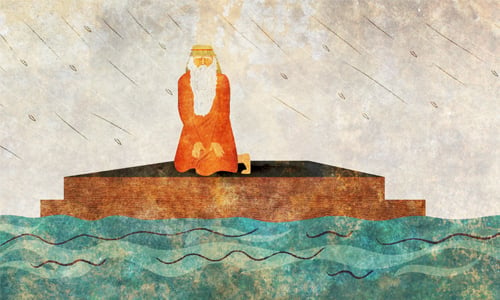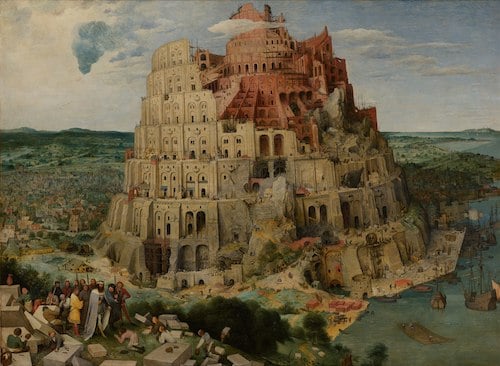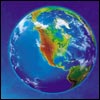The Story of Noah and the Ark in the Bible

The Great Flood (known as the mabul in Hebrew) was sent by G‑d in the year 1656 of Creation (2105 BCE), to cleanse the earth of mankind’s corrupt ways. The only survivors were Noah, his family, and representatives of every living species, who found refuge in a specially designed ark.
The Pre-Flood World
The world preceding the Flood was marked by abundance, health, and prosperity. The average human lifespan lasted many hundreds of years, and the climate across the globe was temperate and pleasant.2
Unfortunately, mankind took advantage of this blissful lifestyle, and corruption became rampant. With the exception of a few select individuals,3 society indulged in theft, idolatry, and incest. This all came to a head in the year 1536 of Creation (2225 BCE), when G‑d first foretold the events that would come to pass.
Noah Builds the Ark
Scripture tells us that Noah, a ninth-generation descendant of Adam and Eve, was a righteous and upright man. G‑d informed Noah of his plans to eradicate mankind due to their evil ways, and instructed him to build an ark, in which he and his family were to take refuge. Joining them in the ark would be a select few creatures of every species (other than fish, that survived the Flood unscathed): two from every non-kosher animal, and seven (or fourteen4) of every kosher animal.
G‑d gave exact instructions how the ark was to be built. It was to be crafted of gopherwood5 and sealed from both within and without with pitch. It was to comprise three stories: the top for Noah and his family; the middle for the animals; and the bottom for refuse. It was to measure 300 cubits in length, 50 cubits in width, and 30 in height. The ark was illuminated by a tzohar, which waseither a window through which light shone from the outside, or a radiant precious stone.
Read more: The Ark
The ark took Noah no less than 120 years to build, allowing plenty of time for onlookers to query his actions, be told of the impending calamity, and change their ways. Unfortunately, such repentance never came to pass.
Finally, in the year 1656 (2105 BCE), the day arrived when everything would change.
The Flood

On the seventeenth day of the Hebrew month of Cheshvan, rain began to fall. In addition, jets of steaming water shot forth from the depths of the earth. The downpour continued for forty days and forty nights, until the face of the earth was entirely submerged, covering the summits of the highest mountains with water 15 cubits deep.
Finally, the rain subsided, but the waters continued to churn for an additional 150 days. After this period of time, the water level slowly began to recede, until the ark rested on the mountains of Ararat.6
To determine the extent of the water’s retreat, Noah sent out a raven, but the bird did not fly that far and merely circled the ark. Next, Noah sent out a dove for a total of three missions. The first time the dove left the ark, it returned without any results. The second time, it returned with an olive leaf in its beak, indicating that new growth had begun to sprout. (Read more: Ode to an Olive Leaf.) The third and final time, it did not return, having found rest outside the confines of the ark.
Finally, on the first day of the Hebrew month of Tishrei of the year 1657 (2104 BCE), the water completely subsided. Close to two months later, on the twenty-seventh of Cheshvan, the ground fully dried, allowing Noah and the rest of the ark’s inhabitants to emerge.
The total time Noah spent in the ark was 365 days (one solar year; one year and 11 days on the lunar calendar).
The Flood: A Timeline

The following is a chronology of the Flood, as indicated by the dates and time periods given in the Torah’s account and calculated by Rashi:7
Cheshvan 17 (mid-fall): Noah enters ark; rains begin.
Kislev 27 (early winter): Forty days of rain end; beginning of 150 days of water’s swelling and churning.
Sivan 1 (early summer): Water calms and begins to subside at the rate of one cubit every four days.
Sivan 17: The bottom of the ark, submerged 11 cubits beneath the surface, touches down on the top of the mountains of Ararat.
Av 1 (summer): The mountain peaks break the water’s surface.
Elul 10 (late summer): Forty days after the mountain peaks become visible, Noah opens the ark’s window and dispatches a raven.
Elul 17: Noah sends the dove for the first time.
Elul 23: The dove is sent a second time, and returns with an olive leaf in its beak.
Tishrei 1 (early fall): Dove’s third mission. Water completely drained.
Cheshvan 27: Ground fully dried. Noah exits ark.
(This chronology follows the opinion of the Talmudic sage Rabbi Eliezer. According to Rabbi Joshua’s interpretation, the Flood began on Iyar 17, and all above dates should be moved ahead six months.8)
Life in the Ark
Life in the ark was no picnic. The Midrash relates that throughout their year-long sojourn in the ark, Noah and his sons barely slept, as they were completely preoccupied with feeding the animals and birds. Each animal needed to be given its specific nourishment at an exact time during the day.9
The tremendous workload and pressure caused Noah to cough up blood. What’s more, Noah was once late in bringing food to the lion, and the angry cat bit Noah.
How did the ark manage to contain hundreds of thousands of species of animal life, not to mention the food necessary to feed them for a full year? According to one approach, the ark was miraculous in nature, allowing for a shipload far beyond the ark’s dimensions.10
Read more: Why Build a Too-Small Ark?
Aftermath and Legacy
Upon leaving the ark, Noah erected an altar and sacrificed some of the kosher animals and birds to G‑d. Subsequently, G‑d promised to never again eradicate all of humanity. To this end, G‑d established a covenant with Noah and his descendants, and he strengthened the covenant by means of a rainbow. “Whenever humanity is unworthy,” said G‑d to Noah, “and potential thoughts of destruction rise before Me, I will cause a rainbow to appear among the clouds. This will remind Me of My covenant, and I will hold back these thoughts from materializing.”
Read more: Significance of the Rainbow in Judaism
Following the Flood, G‑d enjoined Noah and his children with the commandment of procreation. Additionally, G‑d granted allowance to Noah and his descendants to partake of animal meat (as long as the animal was not alive at the time of consumption), which had been forbidden up until that point.
Read more: Judaism and Vegetarianism
In the days following the Flood, Noah planted a vineyard and made wine from its produce. He then partook of the wine and became intoxicated, causing him to lie uncovered in his tent. While Noah’s sons Shem and Japheth took pains to cover their father’s nakedness, their brother Ham and Ham’s son Canaan disrespected him. This led Noah to curse Canaan, stating that he would be a slave to his brethren, and to bless Shem and Japheth.
Read more: Why Noah Planted a Vineyard and Got Drunk
The Flood was followed by a calamity of a different sort: the Dispersion. In the year 1996 of Creation (1764 BCE), a multitude of nations gathered in the valley of Babylon. With the joint goal of challenging G‑d, they began building a city, overlooked by a tower—the Tower of Babel—that was to reach the heavens. When G‑d saw their plans, he limited each nation to speaking and understanding a unique language. Unable to communicate, they disbanded their plans, and G‑d dispersed them over the face of the earth.

The Tower of Babel by Pieter Bruegel the Elder (1563)
Read more: The Tower of Babel: What Was Up With It?
Deluge of Purity
At first glance, the Flood appears to have been an act of cosmic wrath. But Kabbalahteaches that the foremost energy that guides the cosmos is that of chessed, goodness and compassion. Wrath is incompatible with this spiritual posture. There is clearly something much more sublime in the account of the Flood.
Chassidic teachings describe the Flood as a cleansing process. The waters of the Flood are like the waters of a ritual bath—a mikvah—where the waters spiritually cleanse the one who enters it. The world similarly received a spiritual cleansing, setting the course of history on a course of hope and purpose. And just as a mikvah must contain 40 seah (an ancient measure of volume), so did the rains of the Flood last for forty days.13
Read more: The Forty-Day Mikveh
FOOTNOTES
1.
Unless otherwise noted, the material in this article is gleaned from these chapters and their commentaries.
2.
See Bereishit Rabbah 34:11. Midrash Tanchuma, Bereishit 12. Seforno to Genesis 8:22.
3.
See Maimonides, Avodah Zarah 1:2.
4.
See Siftei Chachamim to Genesis 7:2. Rabbi Abraham Ibn Ezra to Genesis 6:19. Nachmanides to Genesis 7:8-9.
5.
The identity of this wood is unclear. Among the possibilities are cypress, boxwood, teak, brazil wood, and pine (see Zohar Amar, Tzimchei Hamikra pp. 198-199).
6.
Popularly identified with the two peaks of Mt. Ararat known as Greater Ararat and Little Ararat, on the border of Turkey and Armenia (see Rabbi Aryeh Kaplan, Living Torah Genesis 8:4).
7.
For an alternative view, see Nachmanides to Genesis 8:4.
8.
See Rashi to Genesis 7:11 and 8:5.
9.
Midrash Tanchuma, Noah 2 and 9.
10.
Nachmanides to Genesis 6:19. Kli Yakar to Genesis 6:21.
12.
Likkutei Sichot vol. 25, pp. 29-30.
13.
Torah Ohr 8c-d.
Related Topics
- Ham (8)
- Shem (9)
- Japheth (5)
- Seven Noahide Laws (65)
- Ark, Noah's (30)
- Noah Dispatches Raven and Doves (13)
- Flood, The (70)
- Noah (43)
- Jewish History (44)





A few educated guesses if I may, in two parts :
- The fact that the waters were swelling and churning indicates a maximal volcanic activity at that time, probably all around the globe.
- This would therefore be the period when :
* continents came to existence, getting separated from one another
* fossilization took place
* mountains were formed from rocks previously under water (which explains the presence of marine fossils embedded in the highest mountains)
* time calculation by isotopic dating of any event prior to the mabul got rendered totally inaccurate, since the radioactivity created by the volcanic activity affected all material things.
- Supposing that Mount Ararat's altitude has not changed since Noach (a little above 5000 m), and supposing that the average altitude of the Earth above sea level was close to what it is now (840m), it takes a tremendous amount of additional water to cover the Earth up to the top of Mount Ararat : 2 billion cubic km, which is 1.5 the amount of known existing waters on Earth !
- Where did this water come from ? The answer could lie in ringwoodite, a recently discovered rock, hidden some 700 km under the Earth surface, rich in O and H, the components of water. Under high pressure and temperature conditions, this rock will melt and release the O and H in the atmosphere.
It is believed that this underground potential ocean contains up to three times the amount of existing water on Earth…
(Psalms 104:24) How great/many are Your deeds, Hashem ! All of them You have made with wisdom, the earth is full of Your creations